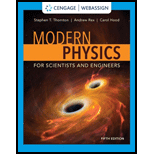
The speed and radial acceleration for a ground-state electron in the hydrogen atom.
Answer to Problem 16P
The speed for a ground-state electron in the hydrogen atom is
Explanation of Solution
If an electron rotates around the nucleus then the expression for speed is given below:
Here,
Multiply by
Value of
Write the expression for radial acceleration.
Here,
For hydrogen like lithion ion
Write the expression for maximum Coulomb force.
Here,
Write the expression for centripetal force.
Here,
From equation (III) and (IV) solve and rearrange the equation for value of
Write the expression for radius.
Here,
Substitute
Conclusion:
Substitute
Substitute
For Lithium ion:
Substitute
Substitute
Thus, the speed for a ground-state electron in the hydrogen atom is
Want to see more full solutions like this?
Chapter 4 Solutions
MODERN PHYSICS F/SCI..-WEBASSIGN(MULTI)
- Suppose the inteference pattern shown in the figure below is produced by monochromatic light passing through a diffraction grating, that has 260 lines/mm, and onto a screen 1.40m away. What is the wavelength of light if the distance between the dashed lines is 180cm? nmarrow_forwardHow many (whole) dark fringes will produced on on an infinitely large screen if red light (2)=700 nm) is incident on two slits that are 20.0 μm apart?arrow_forwardCan someone help me with this physics 2 problem thank you.arrow_forward
 Principles of Physics: A Calculus-Based TextPhysicsISBN:9781133104261Author:Raymond A. Serway, John W. JewettPublisher:Cengage Learning
Principles of Physics: A Calculus-Based TextPhysicsISBN:9781133104261Author:Raymond A. Serway, John W. JewettPublisher:Cengage Learning University Physics Volume 3PhysicsISBN:9781938168185Author:William Moebs, Jeff SannyPublisher:OpenStax
University Physics Volume 3PhysicsISBN:9781938168185Author:William Moebs, Jeff SannyPublisher:OpenStax Modern PhysicsPhysicsISBN:9781111794378Author:Raymond A. Serway, Clement J. Moses, Curt A. MoyerPublisher:Cengage Learning
Modern PhysicsPhysicsISBN:9781111794378Author:Raymond A. Serway, Clement J. Moses, Curt A. MoyerPublisher:Cengage Learning College PhysicsPhysicsISBN:9781305952300Author:Raymond A. Serway, Chris VuillePublisher:Cengage Learning
College PhysicsPhysicsISBN:9781305952300Author:Raymond A. Serway, Chris VuillePublisher:Cengage Learning Physics for Scientists and Engineers with Modern ...PhysicsISBN:9781337553292Author:Raymond A. Serway, John W. JewettPublisher:Cengage Learning
Physics for Scientists and Engineers with Modern ...PhysicsISBN:9781337553292Author:Raymond A. Serway, John W. JewettPublisher:Cengage Learning College PhysicsPhysicsISBN:9781938168000Author:Paul Peter Urone, Roger HinrichsPublisher:OpenStax College
College PhysicsPhysicsISBN:9781938168000Author:Paul Peter Urone, Roger HinrichsPublisher:OpenStax College





